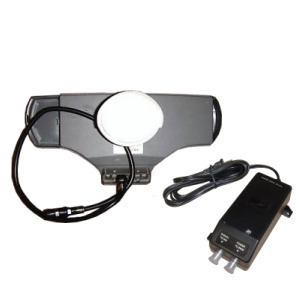DirecTV SWM
The DirecTV Single Wire Multiswitch (SWM) is a specially designed piece of hardware that allows a DirecTV satellite dish signal to be split and used with many different tuners/receivers. The usual configurations allow 5, 8, 16, or 32 connections to a single satellite dish.
DirecTV SWM is useful because of the satellite dish’s previous configurations, where lines were run to the household or location. The satellite dish had to send out a dedicated line that would power a single tuner/receiver. If a DVR was used, two dedicated lines would have to be sent from the dish into the home. Most satellite dishes could only directly send a maximum of 4 dedicated lines. The SWM eliminated the extra bulk by making it possible to send a single designated line into the hardware and successfully splitting it into as many signals as needed.
Solutions to Modern Wiring Problems
The SWM is capable of solving several of the problems that could occur when a DirecTV satellite dish is installed.
Having a single line installed into the home and needing extra lines for multiple receivers or a DVR is one of the major problems. Many customers want multiple receivers or a DVR, but without the extra drilling that must be done to send multiple lines into the home. The SWM easily solves this problem as it can split the line inside the household to run the additional cables where they are needed without drilling. The amount of extra lines available depends on the SWM’s size.
The SWM makes it possible to combine an off-air antenna and cable service into the same line as the DirecTV signal, which is known as diplexing. This makes it simple to switch to HD off-Air, Cable Programming, or DirecTV Satellite signals. This option may be attractive to people who live in an area where they can get many additional channels that may not be available through DirecTV.
SWM Setup Requirements
In order to use an SWM, it is important to have the appropriate requirements/prerequisites.
The first requirement is a satellite dish that is compatible with the SWM. The next requirement is an SWM compatible receiver. Most modern day dishes and receivers are SWM compatible.
The dishes that are compatible with SWM are the 5LNB in either the slim-line or regular configuration in AT9 or AU9. The slim-line 3LNB from DirecTV is the other compatible satellite dish at the moment.
There are several receivers that are compatible with the SWM options on the market. They are the HR20-100 through HR20-700, HR21-100 through HR21-700, HR21 Pro (in all models/configurations), HR22-100 through HR22-700, HR23-100 through HR23-700, HR24, H20-100 through H20-700, H21-100 through H21-700, H22-100 through H22-700, H23-100 through H23-700, H24, R16-100 through R16-700, R22-100 through R22-700, R23-100 through R23-700, D12-100 through D12-700, and D13-100 through D13-100.
The proper satellite dish and receivers allow the user to gain multiple tuner/receiver signals that can be used within the household. In order to configure the system without hitting snags during installation, all of the hardware must be compatible with the system.
Connecting the SWM
Depending on the SWM’s configuration, the number of inputs that can be routed into the receivers vary. The SWM is designed to accept the signal from the satellite that will be run to the SWM via a series of lines. It usually receives 4 lines from the satellite dish. One such satellite dish that is also used to create the signal is the 5LNB. They must be connected to the inputs, which are then split into the signals that will be distributed to the satellite receivers. It is important that the inputs are connected correctly so that the proper channels are shown and errors are reduced. Errors generally occur when the SWM connections are configured incorrectly.
There are six satellite inputs in an SWM-8 configuration. They are usually 18V SAT99/101, 13V SAT99/101, 18V/22kHz SAT 103/110/119, 13V/22kHz SAT 103/110/119, and 2 extra flex ports. The flex ports can be used with cable programming or an off air digital antennae signal.
Splitters may have to be used when the SWM-8 does not come with multiple IRD switches. Whether splitters are used is dependent on how large the SWM is (5, 8, 16, 32). So, an SWM-8 can connect a maximum of 8 separate receivers/tuners or 4 DVRs. Receivers/tuners and DVRs can also be combined, but 2 lines out of the possible 8 are necessary for each DVR.
The SWM can be as far as 40 feet away from the dish location. The lines stemming from the SWM and splitters decrease with each additional line. When used with an SWM, one or two receivers can be a maximum of 300 feet away from the SWM. Up to 4 can be connected with a maximum cable length of 250 feet. When up to 8 are in use, the lines must be less than 200 feet. This distance gets shorter as the amount of receivers placed on the same SWM increase.
If a larger SWM is used, a power inserter (when applicable) makes it possible to have limitless distance (in relation to feasible distance that is possible with this configuration) and receivers connected to the system. The SWMs can be chained together to create more connections that can be used with the system as well. It is not impossible to have hundreds of satellite receivers/tuners and DVRs connected to a single satellite dish from DirecTV. Large setups like this need a wiring diagram and a polarity locker to help ensure a reliable signal.


Comments - 6 Responses to “DirecTV SWM”
Sorry but comments are closed at this time.